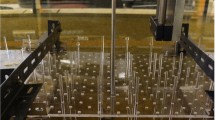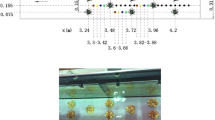Abstract
Vegetation in open channels alters turbulent and other hydraulic characteristics of flow. Hence, conventional methods for computing bed shear stress in bare channels are not applicable in such channels. The present study, therefore, experimentally investigates the distributions of velocity in 3D in gravel bed channels with vegetation and investigates six different methods for estimating bed shear stress. The distribution of shear stress is basically controlled by the spatial distribution of vegetation as well as the biomechanical and architectural features of these plants. It is found that near the bottom of the flume, the shear stress changes in dense layers, constituting a layered shape.










Similar content being viewed by others
Abbreviations
- A V :
-
Frontal projected area of the stem for the emergent vegetation
- Br:
-
Numerical constant of integration
- C D :
-
Drag coefficient
- D :
-
Frontal projected
- d 50 :
-
Median diameter of sediment particles H flow depth
- g :
-
Gravitational acceleration
- H :
-
Flow depth
- K :
-
Karman's universal constant (k = 0.4)
- k s :
-
Equivalent sand roughness
- m :
-
Vegetation density
- s :
-
Energy slope that is equal to bed slop in uniform flow
- U':
-
RMS value of the velocity fluctuation in the longitudinal direction
- U :
-
The velocity components in the streamwise direction (mean velocity)
- U * :
-
Shear velocity
- U f :
-
Turbulence fluctuations in the longitudinal directions
- V':
-
RMS value of the velocity fluctuation in the transverse direction
- V :
-
The velocity components in the transverse direction
- W':
-
RMS value of the velocity fluctuation in the vertical direction
- W :
-
The velocity components in the vertical direction
- W f :
-
Turbulence fluctuations in the vertical directions
- z :
-
Axis perpendicular to the bed
- Z :
-
Flow depth from the bed of channel
- z/H:
-
Relative flow depth
- ρ:
-
Water density
- τ0 :
-
Bed shear stress
- τRey :
-
Local Reynolds stress
- τt :
-
Total shear stress
- τvis :
-
Local viscous stress
- \(\vartheta\) :
-
Kinematic viscosity of flow
References
Afzalimehr H, Dey S (2009) Influence of bank vegetation and gravel bed on velocity and reynolds stress distributions. Int J Sedi Res 24(2):236–246
Afzalimehr H, Setayesh P (2018) Investigation of logarithmic law and Coles’ law for different emergent vegetation patches. Iranian Hydra J 13(1):47–62
Afzalimehr H, Sui J, Moghbel R (2010a) Hydraulic parameters in channels with wall vegetation and gravel bed–field observations and experimental studies. Int J Sed ResVol 25(1):81–89
Afzalimehr H, Fazel E, Singh VJ (2010b) Effect of vegetation on banks on distributions of velocity and reynolds stress under accelerating flow. J Hydrol Eng Am Soc Civil Eng (ASCE) 15(9):708–713
Afzalimehr H, Fazel E, Ghalichand J (2012) Effects of accelerating and decelerating flows in a channel with vegetated banks and gravel bed. Int J Sed Res 27(2):188–200
Afzalimehr H, Moradian M, Sui J, Gallichand J (2016) Effect of adverse pressure gradient and vegetated banks on flow structure. J Riv Res and App. https://doi.org/10.1002/rra.2908
Afzalimehr H, Barahimi M, Sui j, (2019a) Non-uniform flow over cobble bed with submerged vegetation strip. Proc Inst Civil Eng Water Manag 172(2):86–101
Afzalimehr H, Riazi P, Jahadi M, Singh VP (2019b) Effect of vegetation patches on flow structures and friction factor. ISH J Hydra Eng. https://doi.org/10.1080/09715010.2019.1660920
Biron PM, Robson C, Lapointe MF, Gaskin SJ (2004) Comparing different methods of bed shear stress estimates in simple and complex flow fields. Earth Surf Proc and Landforms 29(11):1403–1415. https://doi.org/10.1002/esp.1111
Brahimi M, Afzalimehr H (2019) Effect of submerged vegetation density on flow under favorable pressure gradient. SN App Sci 1(1):57
Dey S (2014) Fluvial Hydrodynamics: Hydrodynamic and Sediment Transport Phenomena. Springer, Berlin
Fazlollahi A, Afzalimehr H, Sui J (2015) Effect of slope angle of an artificial pool on distributions of turbulence. J Int Sed Res 30:93–99
Fazlollahi A, Afzalimehr H, Sui J (2015) Impacts of pool and vegetated banks on turbulent flow characteristics. Canadian J Civil Eng. https://doi.org/10.1139/cjce-2015-0172
Follett EM, Nepf HM (2012) Sediment patterns near a model patch of reedy emergent vegetation. Geomorphology 179:141–151
Goring D, Nikora V (2002) Despiking acoustic doppler velocimeter data. J Hydra Eng 128(1):117–126
Graf WH, Altinakar MS (1998) Fluvial hydraulics-flow and transport processes in channels of simple geometry. Wiley, New York
Hamidifar H, Keshavarzi A, Rowi´nski PM, (2020) Influence of rigid emerged vegetation in a channel bend on bed topography and flow velocity field: laboratory experiments. J Water 12(1):118
Huai WX, Zeng YH, Xu ZG, Yang ZH (2009) Three-layer model for vertical velocity distribution in open channel flow with submerged rigid vegetation. Adv in Water Res 32:487–492
Huai W, Wang W, Hu Y, Zeng Y, Yang Z (2014) Analytical model of the mean velocity distribution in an open channel with double-layered rigid vegetation. Adv in Water Res 69:106–113
Jahadi M, Afzalimehr H, Ashrafizade M, Kumar B (2020) A numerical study on hydraulic resistance in flow with vegetation patch. ISH J Hydra Eng 1–8
Kitsikoudis V, Yagci O, Kirca VSO, Kellecioglu D (2016) Experimental investigation of channel flow through idealized isolated tree-like vegetation. Environ Fluid Mech 16:1283–1308. https://doi.org/10.1007/s10652-016-9487-7
Kitsikoudis V, Yagci O, Kirca VSO (2020) Experimental analysis of flow and turbulence in the wake of neighboring emergent vegetation patches with different densities. Environ Fluid Mech. 20(6):1417–1439
Klopstra D, Barneveld HJ, Noortwijk JM, Velzen EH (1997) Analytical model for hydraulic roughness of submerged vegetation. Proc 27th IAHR Cong in San Francisco, USA, 775–780
Liu C, Luo X, Liu X, Yang K (2013) Modeling depth-averaged velocity and bed shear stress in compound channels with emergent and submerged vegetation. Adv Water Res 60:148–159
Nasiri E, Afzalimehr H, Sui J (2010) Effect of vegetation channel banks on velocity distributions, characteristics of shear stress and turbulence intensities. Int J Sed Res 25(2):110–118
Nasiri E, Afzalimehr H, Singh VP (2011) Effect of bed forms and vegetated banks on velocity distributions and turbulent flow structure. J Hydro Eng ASCE 16(6):495–507
Nasiri Dehsorkhi E, Afzalimehr H, Gallichand J, Rousseau A (2013) Turbulence measurements above fixed gravel dunes. Int J Hydra Eng 2(5):101–114
Neary VS (2003) Numerical solution of fully developed flow with vegetative resistance. J Eng Mech 129(5):558–563
Righetti M (2008) Flow analysis in a channel with flexible vegetation using double averaging method. Acta Geophy 56(3):801–23. https://doi.org/10.2478/s11600-008-0032-z
Righetti M, Armanini A (2002) Flow resistance in open channel flows with sparsely distributed bushes. J Hydro 269(1–2):55–64. https://doi.org/10.1016/S0022-1694(02)00194-4
Sellin RHJ, Vanbeesten DP (2004) Conveyance of a managed vegetated two stage river channel. Proc Inst Civil Eng Water Manag 157(1):21–33. https://doi.org/10.1680/wama.2004.157.1.21
Shahmohammadi R, Afzalimehr H, Sui J (2018) Interaction of turbulence and vegetation patch on the incipient motion of sediment. Canadian J Civil Eng 45(9):803–816
Shimizu Y, Tsujimoto T (1994) Numerical analysis of turbulent open-channel flow over a vegetation layer using a k–e turbulence model. J Hydrosc and Hydra Eng 11(2):57–67
Tang H, Tian Z, Yan J, Yuan S (2014) Determining drag coefficients and their application in modelling of turbulent flow with submerged vegetation. Adv in Water Res 69:134–145
Thompson AM, Wilson BN, Hansen BJ (2004) Shear stress partitioning for idealized vegetated surfaces. Trans ASAE. 47(3):701–9
Wilson C (2007) Flow resistance models for flexible submerged vegetation. J Hydrol 342(3–4):213–222
Wilson C, Yagci O, Rauch HP, Stoesser T (2006) Application of the drag force approach to model the flow interaction of natural vegetation. Int J River Basin Manag 4(2):137–146. https://doi.org/10.1080/15715124.2006.9635283
Wilson C, Yagci O, Rauch HP et al (2006) 3D numerical modeling of a willow vegetated river/floodplain system. J Hydrol 327(1–2):13–21
Wolman MG (1954) A method of sampling coarse riverbed material. J Trans-Am Geophysc Union 35:951–956
Yagci O, Kabdasli M (2008) The impact of single natural vegetation elements on flow characteristics. Hydrol Proc 22:4310–4321
Yagci O, Celik MF, Kitsikoudis V, Kirca VO, Hodoglu C, Valyrakis M, Duran Z, Kaya S (2016) Scour patterns around isolated vegetation elements. J Adv Water Resour 97:251–265. https://doi.org/10.1016/j.advwatres.2016.10.002
Yagci O, Yildirim I, Celik MF, Kitsikoudis V, Duran Z, Kirca VSO (2017) Clear water scour around a finite array of cylinders. Appl Ocean Res. 68:114–129. https://doi.org/10.1016/j.apor.2017.08.014
Yang JQ, Kerger F, Nepf HM (2015) Estimation of the bed shear stress in vegetated and bare channels with smooth beds. Water Resour Res 51(5):3647–3663. https://doi.org/10.1002/2014WR016042
Acknowledgements
We thank Dr. Oral Yagci reviewer for their useful comments.
Author information
Authors and Affiliations
Corresponding author
Rights and permissions
About this article
Cite this article
Setayesh, P., Afzalimehr, H. Effect of Reedy Emergent Side-Vegetation in Gravel-Bed Streams on Bed Shear Stress: Patch Scale Analysis. Iran J Sci Technol Trans Civ Eng 46, 1375–1392 (2022). https://doi.org/10.1007/s40996-021-00630-x
Received:
Accepted:
Published:
Issue Date:
DOI: https://doi.org/10.1007/s40996-021-00630-x




